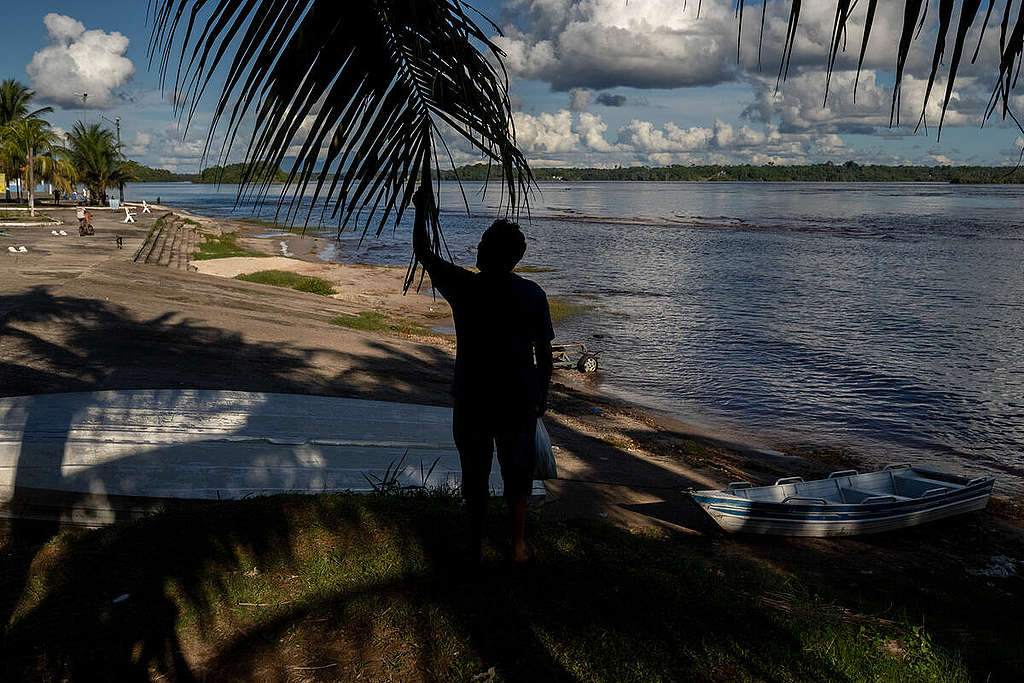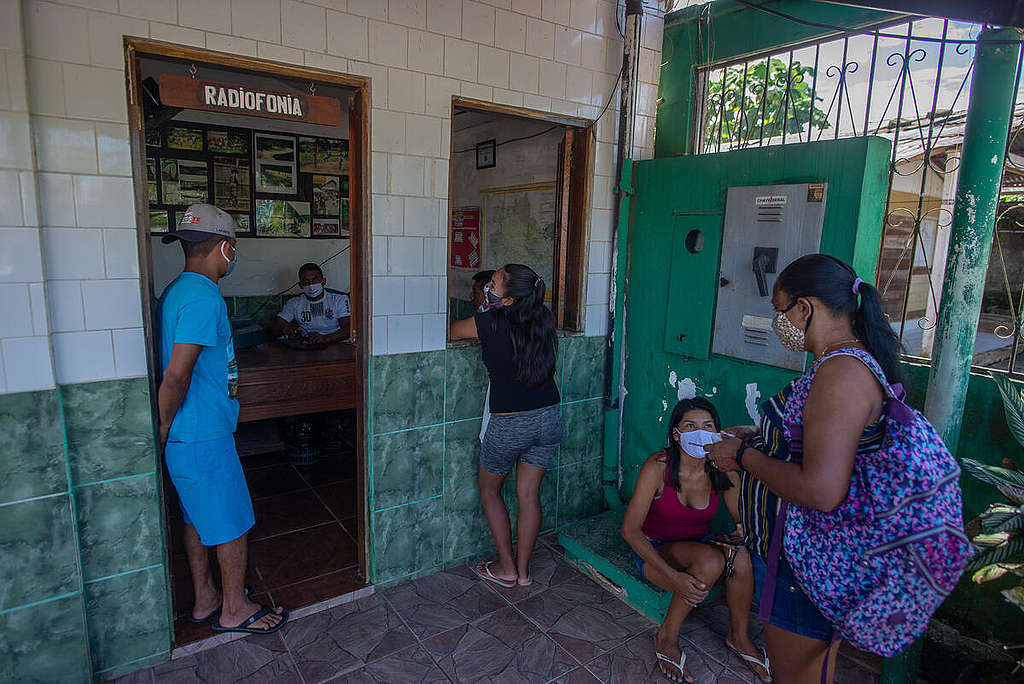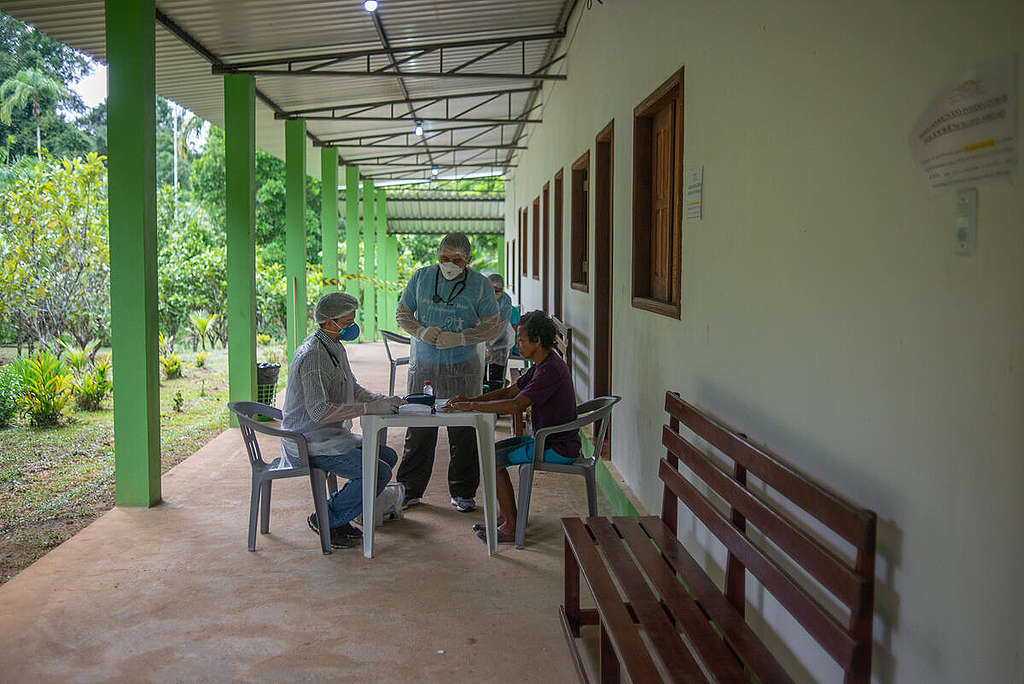by Luana Lila
The original version of this story was published in Portuguese on July 13 by Greenpeace Brazil.
Since the novel coronavirus pandemic hit Brazil, an alarm has been ringing for the country’s Indigenous Peoples. Already with a history of destruction caused by epidemics transmitted by non-Indigenous People, COVID-19 brought a frightening reminder of a past that must not be repeated.
Despite every warning of how vulnerable Indigenous Peoples are to COVID-19 – the Indigenous People’s mortality rate in the Amazon is 150% higher than the Brazilian average, according to a study published in June – the federal government has taken minimal action to protect these populations from the pandemic. Last month, President Jair Bolsonaro went as far as vetoing 16 items from a project
with measures to prevent the spread of the virus within Indigenous communities.

According to data from the Coordination of the Indigenous Organizations of the Brazilian Amazon (COIAB), as of August 21, there are 19,893 confirmed cases of Indigenous People infected by COVID-19, 588 registered deaths, and 125 affected ethnicities in the Amazon. Amazonas was the first state to confirm cases of infected Indigenous people and has the highest concentrated number of deaths among them.
In São Gabriel da Cachoeira (AM), the city in Brazil with the highest number of Indigenous Peoples (approximately 90% of the population), located on the Colombia-Venezuela border, a multi-institutional effort has been mitigating the impacts of the pandemic. The effort is aiming to stop the disease from advancing further through the forest and avoid catastrophic consequences.
The Coping with COVID-19 Committee was created by São Gabriel da Cachoeira’s City Hall on March 18th, and a group of organizations and civil society, such as the Federation of Indigenous Organizations of Rio Negro (FOIRN), Brazil’s National Indigenous Foundation (FUNAI), the Socio-Environmental Institute
(ISA), Municipal Department of Health, Special Indigenous Sanitary District (DSEI) and the Army. The group began implementing actions to fight COVID-19 before the disease reached the town.
Communication and information efforts about the disease were some of the preventative measures taken. São Gabriel has three other official languages (Nheengatu, Tukano and Baniwa) in addition to Portuguese, so booklets were produced in the Indigenous languages and information was broadcasted via radio and sound trucks, with the support of young communicators from the Wayuri Indigenous Communication Network

Sanitary barriers were also installed as another preventive measure to control the water and air traffic. “This held us over for 37 days [until the virus arrived],” says Marivelton Barroso, Indigenous leader, president of FOIRN, and current president of the Committee. “But we also had some challenges, a lot of people didn’t like these barriers, saw it as a hassle and started to come through the back door. Today we don’t know where the virus began to spread, but when it broke out in April, it was already out of control.”
The residents of São Gabriel da Cachoeira were alarmed when the first confirmed cases of COVID-19 in their city hit the news. “It is one thing for you to watch the pandemic on television in other states and countries, but when it arrived, and we saw the reality, we were scared. Five people died in their homes in one weekend. It was a desperate time,” recalls Wizer Almeida of the Baré people, from ISA.With only one hospital in town, the healthcare system collapsed
, lacking hospital beds, health professionals and with a low supply of oxygen. The hospital does not have an Intensive Care Unit (ICU) and, at the beginning of the pandemic, had only seven respirators for treating COVID-19 patients. Therefore, the city government ordered a lockdown from May 9th to June 8th and made the use of masks mandatory. By August 23, São Gabriel da Cachoeira had 3,749 confirmed cases, and 51 registered deaths.

According to Marivelton, the effort that brought together such diverse institutions, between authorities and civil society, was vital in dealing with this enormous and logistically challenging situation—about 750 communities of 23 Indigenous ethnicities. “Interinstitutional work is crucial and regionally strategic. If we hadn’t joined forces, the situation could’ve been much worse. This model has to continue even after the pandemic,” he said.
Greenpeace Brazil joined forces with the Committee as time moved along by enabling donated materials to be transported, both by the organization itself and by partner organizations. “We really need to understand the challenges faced by those who live in the Amazon, and the threats the pandemic is posing. Those who live in São Gabriel da Cachoeira are 850km from the Manaus, the only city in the entire state that has an ICU,” explains Carol Marçal, from Greenpeace’s Amazon Campaign. “So the formation of this solidarity network is essential to face this crisis.”
Greenpeace and other partners delivered thousands of COVID-19 rapid tests, oxygen tanks and concentrators, power generators and electrical equipment to assemble field hospitals, personal protective equipment, masks, soap, hand sanitizer, food and sewing machines for people to make masks. Healthcare professionals were also taken to the city to run tests, give treatment, assess the status of the municipality’s healthcare infrastructure and train healthcare workers.

A place where Indigenous patients can feel at home
The field hospitals set up to treat Indigenous People during the pandemic are an example of the efforts being made by the Coping with COVID-19 Committee and many supporting organizations
. Called Indigenous Primary Care Units (UAPI), they are coordinated by the Special Indigenous Sanitary District (DSEI) and treat low and medium risk patients, providing an environment adapted to their needs.
12 field hospitals have been set up in the Rio Negro region to offer assistance within communities and keep Indigenous People with lower-risk cases from having to be treated in the city.
Doctor Guilherme Reis Monção, from DSEI, helped make these units viable and explained they are simple operations. They mainly guarantee oxygen, medication, and treatment from doctors and nurses. “If we manage to give treatment early, we will be able to save lives. So, the idea is to take medication and treatment to the community,” he says.
The units also facilitate treatment for the at-risk group, as many elderly people resist going to the cities for treatment for fear of never coming back. “Many people will not want to leave their communities. This is a way of giving them another chance at treatment,” explains Guilherme. The loss of elders is one of the Indigenous Peoples’ utmost concerns. As Marivelton states, the region has already experienced the irreversible loss of elders who held the entire history and knowledge of territories and cultural issues with them. “We call them a living encyclopedia. The elders are the main doctors and teachers, the holders of traditional knowledge,” he says.

“Here you can treat the patients better, they feel more at home,” says Guilherme. The president of the Conselho Distrital de Saúde Indígena (CONDISI), Jovânio Vilagelin, of the Baré People agrees, “The unit was created especially for the Indigenous population. It removes the hospital environment, a very heavy environment for us,” he says. Jovânio explains that, in his language, when people come together to help someone in need, it is called “Ajuri.” “This ajuri – the union of all – made it possible to set up this peaceful, calming environment, so that patients can stay safe,” he adds. According to the DSEI, until July, 84 patients have recovered in one of the Cachoeirinha dos Padres field hospital and were able to return to their villages, including a 102-year old Indigenous woman, whose recovery was widely celebrated. Currently, the field hospital model is being implemented
in other strategic regions of the Amazon. The intention is to decentralize treatment and help reduce the flow of Indigenous patients seeking help in the cities.
Luana Lila is a Communications Analyst at Greenpeace Brazil.

No comments:
Post a Comment
Note: Only a member of this blog may post a comment.